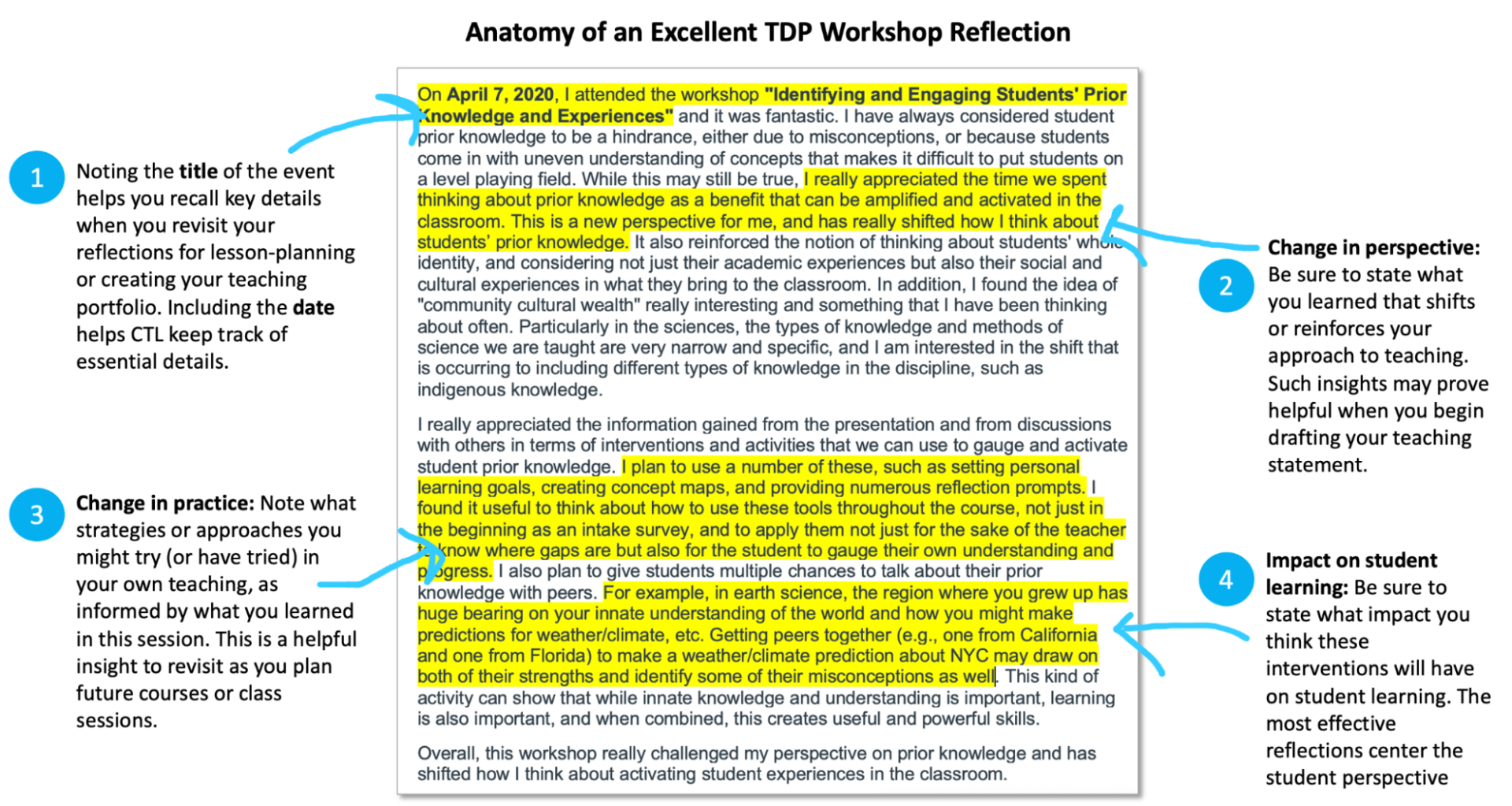Reflection Guidelines
Capture your thoughts as you develop your approach to teaching.
Reflecting in the TDP
The rhythm is simple: participate in a teaching workshop or observation, then post a reflection to get TDP credit. This practice helps you consider and document experiences you have with teaching, learning, and observation in and beyond this program. The questions we ask you to respond to, in writing, are designed to help support and formalize your reflection.
We recognize that participants in the TDP likely have varied experience with reflective writing, so the purpose of this page is to offer a basic orientation to reflective practice, preview how you will be writing and thinking reflectively as part of your TDP participation, and share resources to assist you in that endeavor.
Anatomy of a TDP reflection
Each reflection you write for the TDP will be guided by a simple prompt, which you can find in the respective assignment description. For example, for all workshops you attend, we ask you to reflect on:
- Change in perspective: What did you learn or experience during this session that was unexpected or surprising?
- Change in practice: How might you apply what you learned from this session to improve your teaching and professional practice?
- Impact: What impact might this have on your students’ learning?
In addition to answer these questions, an excellent reflection does the following:
- Provides a brief statement of the session’s key takeaways in the participant’s own words, emphasizing material or outcomes that were unexpected and/or surprising
- Draws out at least one specific point, scenario, idea or question, and considers its significance in reference to the participant’s own teaching practice
- Includes session title and date for specificity
How might this come together in a reflection? In the sample below, notice how the participant responded to each question as part of a cohesive narrative.

Reading through this sample reflection might have suggested some of the beneft of doing this reflective work: it’s a record of your own development and intentionality, which will be helpful as you plan instruction and, eventually, look ahead to articulating your practice to your students and for the job market. Why else might you do this reflective work? Good question. Read on for more!
Support for TDP reflections
Reflective writing is more informal than academic writing, and the reflections you write for the TDP should prioritize showcasing your process of meaning-making over producing perfect writing. You will notice in reflection prompts that we suggest a limit of 300 words for your written reflections. You can write more if doing so is helpful or valuable for your own development, but it is neither required nor necessary for writing a substantive, clear reflection.
The CTL reviews TDP reflections and offers feedback on two of your submissions: one from the Essentials of Teaching and Learning series, and one from the Application and Practice series. This formative feedback is coordinated to rubrics (available below) and is intended to guide future practice.
Here are documents that can help you craft strong reflections in the TDP. CTL uses the rubrics below to assess submitted reflections; refer to them to see what we’re measuring and what we deem to be excellent work. The sample strong reflections were written by participants in the TDP and are shared with their permission.
How reflection supports values in the TDP
Reflective practice is central to the goals of the TDP. In the Foundational Track, we expect that participants will articulate and reflect on their own student-centered approach to teaching, and in the Advanced Track, we expect participants to articulate and reflect on their own inquiry-based development as a teacher.
Why? There are two important reasons to produce these reflections:
Teaching development is fundamentally a learning process. Workshops you attend and observations you conduct and receive are experiences intended to provoke some sort of change to or clarification of your approach to teaching; reflective thinking and writing is what gives form to this process of meaning-making.
Written reflections help you document and begin articulating your own development and approach, which in turn will help you link your experiences in the TDP to future work. By capturing these reflections and related materials, you are creating your own teaching archive: a body of resources that will continue to aid you in your teaching development long after you’ve completed the TDP.
References
Kaplan, M. , Silver, N. , LaVaque-Manty, D. , Meizlish, D. (Eds.). (2013). Using Reflection and Metacognition to Improve Student Learning: Across the Disciplines, Across the Academy. Sterling: Stylus Publishing, LLC.
Kember, D. , Jones, A., Loke, A., McKay, J., Sinclair, K., Tse, H., Webb, C., Wong, F., Wong., M., & Yeung, E. (1999). Determining the level of reflective thinking from students’ written journals using a coding scheme based on the work of Mezirow. International Journal of Lifelong Learning, 18(1), 18-30.
Access TDP Modules
Feeling reflective? Post your thoughts while they’re fresh in mind!
Contact Us
The CTL is here to help as you work through the TDP. Email us anytime.
Get Advice
Request an individual consultation to discuss your TDP progress.
Find Answers
Get quick answers to frequently asked questions.
Attend Sessions
Find and register for offerings that count for the TDP